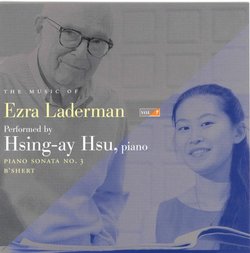Solo Piano Music by a Distinguished American Composer and Ed
J Scott Morrison | Middlebury VT, USA | 08/16/2007
(4 out of 5 stars)
"Ezra Laderman (b. Brooklyn, NY 1924) is a distinguished composer who, among other things, has been Dean of the Music School at Yale. He studied with Stefan Wolpe, Miriam Gideon, Douglas Moore and Otto Luening. In his music he incorporates atonal elements into an extended tonal framework, and he is noted for his creative, even experimental, forms. For instance, in the present work, the 2002 Piano Sonata No. 3, the second movement is actually a collection of ten miniatures inspired by Brahms's late piano pieces, Opp. 116-119. This CD is the seventh in a series of recordings of his music on the Albany label and it features a talented young pianist, Hsing-Ay Hsu, who studied with Herbert Stessin at Juilliard and Claude Frank at Yale. (The booklet notes helpfully suggest that her name is pronounced 'Sing-I Shoo'.)
The Third Piano Sonata was, as the composer indicates in his helpful notes, composed 'completely for myself' without any constraints arising from a commission or the personality or performing style of a particular instrumentalist. It is in three movements: I Fantasia, II Ten Pieces, III Theme and Variations. The first movement begins with an attractive, almost sassy, rhythmically alive first theme that evolves into a pensive consequent theme. These are varied and 'interlocked', to use the composer's term, in a thoroughly convincing working-out. The second movement, as mentioned, consists of ten separate miniatures, none lasting more than three minutes, with strongly contrasting moods. For instance, the first is a will o' the wisp, the third a ruminative andante, the sixth is marked 'forceful, brusque', the eighth a long-limbed lyric outpouring, the tenth a tender melody that is probably the most Brahmsian of all. The third movement is an eleven-minute set of variations on a theme that sounds like a slowed-down inversion of the opening gesture of the first movement. The succeeding variations become more and more dramatic before reaching first a defiant and then a resigned ending.
The CD ends with 'B'shert', a seven-and-a-half minute work written specifically for Hsing-Ay Hsu. Its title in Hebrew means 'It was meant to be'. Laderman indicates that it has an alternate title, the Chinese word 'Yuan', which has the same meaning. It contains moments of contemplation along with a kind of kittenish playfulness and undiluted joy that Laderman says were inspired by the pianist's personality.
Hsu plays these works with what sounds like complete assurance and musical understanding. This is virtuosic music, at least in part, and Hsu manages its demands with aplomb.
Scott Morrison
"


 Track Listings (2) - Disc #1
Track Listings (2) - Disc #1